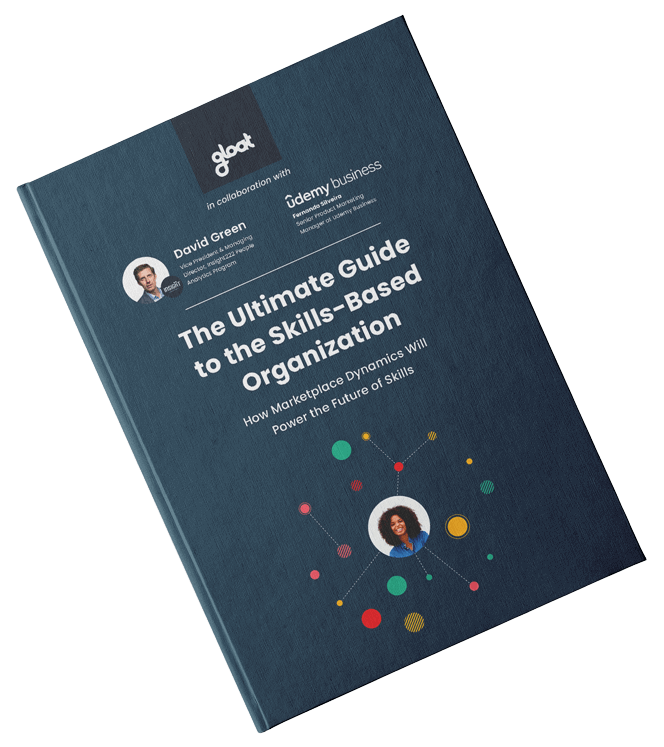What is skill management and how can leaders optimize it?
The tools and strategies leaders need to accurately assess workforce capabilities

As talent shortages continue and the half-life of skills shrinks, most leaders recognize that developing future-fit capabilities deserves a spot at the top of their agendas. HR leaders identified building critical competencies as their top priority and 89% of executives agree that skills are becoming more important for the way their organizations are defining work.
However, companies that are experimenting with skills-based strategies often run into a few challenges, especially when it comes to managing workforce competencies. Since employees are constantly learning new capabilities and knowledge must continuously be updated to keep pace with technological innovations, keeping track of skills often feels like a moving target.
Given their dynamic nature, it’s easy to understand why approximately one in two HR managers believe that their current job and skills information only partially meets their needs. Fortunately, there’s a new generation of AI-powered tools designed to help businesses keep track of their workforce’s capabilities and uncover how to best harness them.
What is skill management?
Skill management is the process of identifying, acquiring, developing, and leveraging the skills individuals and teams possess in order to achieve organizational objectives. It involves the use of a variety of strategies and techniques to ensure that the right people are in the right roles at the right time and that their skills are being used to their full potential.
Another component of skill management is developing and maintaining a pool of skilled personnel in order to meet the organization’s current and future needs.
Traditionally, skill management was a predominantly manual process that relied heavily on self-assessments, skills inventories, and job titles. Yet, as the world of work becomes increasingly on-demand and agile, skill management processes must adapt to keep pace.
Modern approaches are streamlined through the use of AI-based platforms, such as Skills Foundation, which connects all data sets to create one unified system of record for organizational skills. Once leaders gain a comprehensive understanding of the skills within their workforce, they can harness skills-based strategies by deploying employees to projects and tasks based on their competencies.
What goes into an effective skill management approach?
Modern skill management practices typically include:
Skills inventories: A compilation of the skills, education, and experiences that current employees possess. This information is often siloed amongst various HR systems, but tools like Gloat’s Skills Foundation can harmonize all of these data sets to create one system of record.
Skills assessments: Skills assessments describe any process designed to evaluate employees’ competency levels when performing various tasks. Traditionally, most organizations took a manual approach to assess skills, which typically consisted of manager feedback and performance tests. However, many companies are now harnessing AI to infer and enrich skill sets based on market and company data.
Training and development: Based on insights derived from skills inventories and assessments, companies will develop opportunities for employees to broaden and deepen their knowledge. These skill-building opportunities often include content-based courses, in addition to experiential learning such as projects, gigs, and mentorships.
Performance management: Most companies will regularly evaluate the progress that employees are making to ensure they’re meeting pre-defined goals and playing an active role in helping the business achieve organizational objectives.
Skill and job architecture: Job architectures are organizational frameworks designed to help leaders understand how roles are structured and what skills employees in each job might possess. While job architectures are considered to be the backbone of an organization, manual ones quickly become outdated and often fail to capture the full breadth of employees’ skills. To embrace skills-based strategies, leaders must look beyond business units and job codes and harness tools that enable them to deploy talent to projects and tasks at the skill level.
3 top skill management challenges (and how to solve them)
While many organizations are eager to adopt skills-based strategies, they often run into a few overarching skill management challenges, including:
#1. Skills inventories become outdated before they’re complete
Since employees are always learning and knowledge must be continuously updated, the skills that organizations possess are always in a state of flux. That’s a major problem for businesses that track skills manually or those that rely on an off-the-shelf skills taxonomy, because inventories will inevitably become outdated, overly generic, or incomplete.
Organizations are turning to AI-powered tools like Skill Foundation to sidestep this challenge. By connecting to all data sets in your business, Skills Foundation creates a single source of truth for workforce skills that will automatically evolve and expand as your employees hone new competencies.
#2. Skills assessments are subjective and biased
Since one employee or manager may rate their skills proficiency as higher than a colleague who has the same level of expertise, manual reporting is often swayed by biases and inconsistencies. Rather than letting these variances impact talent management decisions, leading companies are harnessing Skills Foundation to accurately assess skill levels.
Beyond weighing manager and employee evaluations, the tool’s algorithm takes into account both years of experience and how long ago employees executed a specific skill to assess capabilities objectively and accurately.
#3. Leaders struggle to identify future skill needs
As the pace of change accelerates and new technological innovations promise to transform the way we work, leaders must identify the skills that will be important in the years to come and start prioritizing their development. Yet, only 10% of HR executives strongly agree they can effectively anticipate the skills they will need over the next three years.
Rather than guessing which capabilities to prioritize, organizations can use Skills Foundation to gain insight into which skills are on the rise and which are declining. It also identifies roles to sunset and emerging areas that require investment, equipping HR leaders with the insights needed to hone future-fit restructuring and reskilling strategies.
To learn more about the tools, frameworks, and strategies that companies are harnessing to manage their workforces’ capabilities, check out our guide to becoming a skills-based organization.





